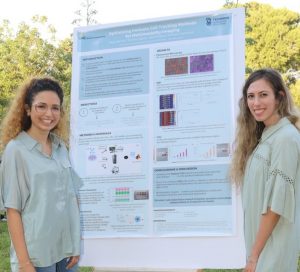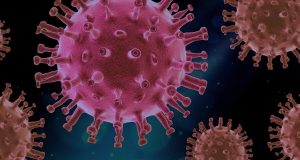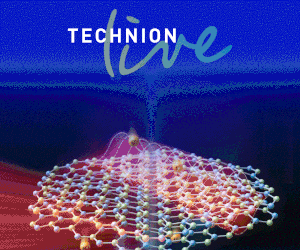Lifesaving Biomed
From fighting COVID-19 to detecting heart disease, these are some of the Technion's most innovative student projects in biomedical engineering
From detecting cardiovascular disease, to fighting coronavirus, Faculty of Biomedical Engineering students recently presented an array of innovative projects that integrated everything they had learned.
During project development, the students had to go through all the stages needed to bring an idea to fruition. Starting with a medical problem which they had to tackle, they had to combine and implement medical know-how with engineering skills and scientific knowledge in order to provide a real-world solution. This hands-on experience exposes and prepares Technion graduates to the high-tech and biomed industries, and to biomedical research in a way that encourages multidisciplinary work. Therefore, such projects are vital for their future career and entrepreneurial skills.
Here’s a glimpse into some of the most intriguing (and often lifesaving) student projects in biomedical engineering.
Early detection of cardiovascular disease
Sivan Barash and Shachar Zigron took first place in the student project competition, presenting a novel way of labelling macrophage cells, making them detectable by MRI. Macrophages are cells involved in the detection and destruction of bacteria. Cardiovascular disease is strongly associated in the public mind with fat storage in the body, but recent studies have shown significant involvement of inflammation in the process. Since macrophage cells have a major role in inflammation, being able to observe their movement within the body would facilitate scientists’ exploration of the connection between inflammation and cardiovascular disease. The duo’s project has lain the groundwork for in-vivo studies soon to be conducted in the laboratory of Prof. Katrien Vandoorne.
AI-based decision support machine for fetal monitoring
Second place went to Amit Parizat and Rotem Shapira, who created an artificial intelligence (AI) system to analyze the output of the fetal monitor during labor and serve as a decision support machine. Complications during labor develop rapidly and can harm mother and child. The fetal monitor alerts healthcare providers of complications during labor. However, analyzing the monitor’s long signals manually is challenging and leads to obstetrics teams recommending a Caesarean “just in case” at the slightest indication, to the point that currently a third of all births in the U.S. involve a C-section, and only 20% of C-sections are later found to have been necessary. C-sections carry risks to the mother and involve a long recovery and long-term side effects. Amit and Rotem proved the feasibility of training an AI machine to predict complications during childbirth, preventing unnecessary invasive intervention, while ensuring that intervention is performed when needed. To achieve this, the two worked with the Obstetrics and Newborn Medicine Division at the Carmel Medical Center.
Treating cancer
Orel Shahadi and Or Levy, coming in third, developed a 3D model that simulates drug penetration into solid tumors, facilitating development of new drugs and drug combinations to treat cancer. Their innovative model features an inner cluster of cells engineered to display fluorescence, surrounded by an outer layer of cells. Change in the cells’ fluorescence served as an indicator, providing a way to measure drug penetration into the tumor with a high level of precision.
Detecting heart rhythm problems through the color of your skin
Yonathan Belicha and Daniel Cherniavsky, who took fourth place, explored a novel approach to diagnosing cardiac arrhythmias (heart rhythm problems), using nothing more than a few 1-minute videos of the patient – the kind of videos one might make using one’s smartphone. The natural contraction and relaxation of the heart cause minute changes in the human skin color. Yonathan and Daniel extracted those very small changes from the video, and from them – the subject’s pulse. Using this, they trained an AI system to recognize cardiac arrhythmia.
Fighting coronavirus with… ultrasound!
Finally, Mor Ventura, Dekel Brav and Omri Magen, coming in fifth, tackled one of the challenges posed by the COVID-19 epidemic. Classification of the COVID-19 severity degree is usually done in hospitals using CT. However, CT machines’ availability is strained, they are expensive, and the process is further complicated by the need to transfer a patient with a highly contagious disease to and from the machine. Mor and Omri explored the possibility of using lung ultrasound instead, obtaining the necessary diagnostic information faster and more easily at the patient’s bedside, also significantly reducing the workload in healthcare facilities. To this end, they first developed an image-processing algorithm to “read” and label lung ultrasounds, identifying areas of interest and ignoring artefacts. Using the results of this algorithm, the trio then trained a neural network to classify the ultrasound videos and identify the severity of the patient’s illness. The project was conducted in collaboration with the Tel Aviv Sourasky Medical Center.
Award-winning FemTech startup
Asaf Licht and Zeinat Awwad presented the entrepreneurship project. Just finishing their bachelor’s degree, the two have already turned their project into a startup called Harmony. Their project is a FemTech initiative, developing a wearable, continuous, and non-invasive tracker to monitor women’s hormonal levels, aiming to ease the process of IVF, but also relevant for avoiding pregnancy, or alternatively for increasing the chances of getting pregnant. Currently, IVF procedures requires a blood test multiple times a week; Harmony seeks to replace that with an at-home device that provides continuous measurements while reducing discomfort. This project won first place in the EuroTech Innovation Day startup competition.
To read about additional student projects recently presented at the Technion, click here, here, and here.
Story by Tanya Haykin





